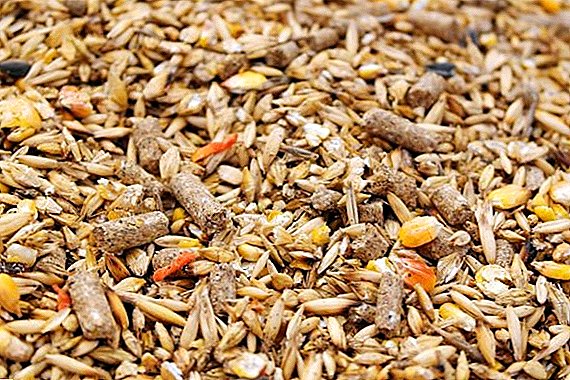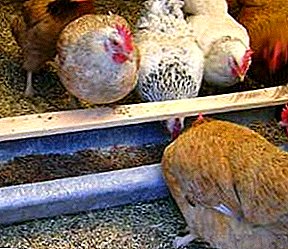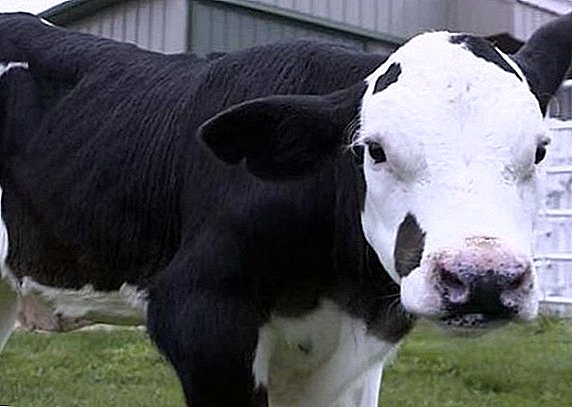 Far from all farmers know that the definition of the term "clostridiosis" means a whole range of diseases that are caused by certain types of clostridia. The symptoms of these ailments may be similar, and may differ significantly, so it is very important to diagnose the problem in a timely manner and address it. Let's find out what is clostridioses in cattle, for what symptoms they can be determined, how to treat and what you should know about preventive measures.
Far from all farmers know that the definition of the term "clostridiosis" means a whole range of diseases that are caused by certain types of clostridia. The symptoms of these ailments may be similar, and may differ significantly, so it is very important to diagnose the problem in a timely manner and address it. Let's find out what is clostridioses in cattle, for what symptoms they can be determined, how to treat and what you should know about preventive measures.
What is cattle clostridia
Under the general definition of clostridioses mean animal diseases triggered by clostridia. These are toxic infections with an acute period, which ultimately usually lead to the death of cattle. All pathogens of such ailments are anaerobic, and can easily exist both in the soil and in manure, or in the aquatic environment. In addition, their disputes may be present in the intestines of clinically healthy individuals, without showing themselves for a long time.  Tetanus, botulism, malignant edema, emcar and anaerobic enterotoxemia are considered to be the main illnesses belonging to the clostridial group.which are often found not only in the mass breeding of livestock, but also in small private farms.
Tetanus, botulism, malignant edema, emcar and anaerobic enterotoxemia are considered to be the main illnesses belonging to the clostridial group.which are often found not only in the mass breeding of livestock, but also in small private farms.
Causes of infection
The causes of clostridiosis in the body are always its pathogens - microorganisms of the genus Clostridium, which includes more than 100 species of bacteria. C. botulinum (causes botulism), C. tetani (the causative agent of tetanus), C. chauvoei (contributes to the development of emcar disease), C. perfringens and C. septicum, which lead to malignant edema and anaerobic enterotoxemia in animals, are considered the most common among cattle.
Did you know? Most of the diseases belonging today to clostridioses existed in ancient times and the Middle Ages, although their causes and pathogens did not immediately become known to mankind. In particular, Hippocrates was involved in the study of the clinical picture of tetanus, and the first documented information about botulism appeared after the mass infection of people in medieval Byzantium.
There are many sources of infection with them, first of all, it is:
- a sick animal or even a person, with waste products of which clostridia get directly to a healthy individual (the alimentary or household contact infection mechanism);
- a soil or a reservoir of water in which the pathogen can exist for a sufficiently long time;
- food and feed residues that, along with bacteria, enter the body of a healthy animal;
- the blood of an infected individual, transfused healthy.
 All these reasons can often be explained by only one violation on the part of the farmer - non-observance of sanitary and hygienic standards in the care of cattle, although often the reason for the mass spread of any disease is a violation of the requirements for the veterinary procedures performed.
All these reasons can often be explained by only one violation on the part of the farmer - non-observance of sanitary and hygienic standards in the care of cattle, although often the reason for the mass spread of any disease is a violation of the requirements for the veterinary procedures performed.
Familiarize yourself with common diseases and cattle vaccination patterns.
Clinical signs
Specific signs of the disease depend on its type and method of ingestion. Most cattle are infected with alimentary or traumatic, and in almost all cases there is intoxication of the body with damage to the gastrointestinal tract and the nervous system of the diseased individual. Among the most typical signs of clostridiosis are convulsive syndrome, muscle paralysis, the appearance of edema and swelling, diarrhea.
Some diseases can be confused (for example, malignant edema and emphysematous carbuncle), but there are illnesses quite unlike the others (for example, signs of tetanus often manifest themselves in convulsions and paralysis of internal tissues and often for a long time are hardly noticeable externally). Consider the symptoms of each of them more closely.
| Disease | Causative agent | Body temperature of an infected animal | Physiological changes | Related signs |
| Botulism | Bacterium C. botulinum | Unchanged, within normal limits | The animal chews food longer than usual, but it still does not move along the esophagus, while water flows from the nostrils. | Excretion of large amounts of saliva, rapid depletion of the body, diarrhea, partial blindness is possible. |
| Tetanus | Bacterium C. tetani | Unchanged, within normal limits | Muscles become very hard, there are frequent convulsions, paralysis, possibly increased sweating. | There are problems in the work of the digestive system, including paralysis of the chewing muscles. General condition - excited. |
| Malignant Edema | Bacteria of species S. septicum, S. novyi, C. perfringens. | An increase of several degrees is possible, but more often within normal limits | The accumulation of foam exudate in the subcutaneous tissue, which leads to swelling and crepitus during palpation. | The general condition of the sick animal is depressed, the appetite decreases, the number of heart contractions increases, breathing becomes more frequent. For 3-5 days the sick individual perishes. |
| Emkar | Bacterium C. chauvoei | Increase to + 41 ... +42 ° C | A limp, a wobbly gait of an animal is noticeable. Hot localized edema is quickly replaced by spilled cold swellings that crack on palpation. If you open the affected area, a rancid, dirty exudate will stand out. In calves, puffiness may not appear. | Appetite decreases, the superficial difficulty in breathing and palpitations are observed. The animal becomes sluggish and depressed. |
| Anaerobic enterotoxemia | Bacterium C. perfringens | Increase to + 41 ... +42 ° C | Coordination of movement is disturbed, loss of balance and muscle spasms are observed. Most often, young individuals are affected. | Pulse and respiration become more frequent, the activity and appetite decreases, there is a release of liquid brown fecal masses with blood and blistering impurities. |
Important! Even in the presence of all the described symptoms of a disease in the cattle, only a doctor can make a final diagnosis. He should prescribe a treatment regimen.
Diagnostics
The most accurate and correct way to diagnose clostridioses is a laboratory test of a biomaterial, which is usually obtained from dead or sick animals. Parts of the affected organs, fecal and mucous masses, blood, and even a part of the intestine with its contents can act as a sample. For each of the above diseases has its own features of diagnosis.
| Disease | Material for laboratory diagnostics | Research method | Differential diseases that need to be excluded |
| Botulism | Blood of a sick animal, feed mixtures, stomach contents, liver particles of animal carcasses. | Search for toxins with subsequent bioassay. | Food poisoning, rabies, anthrax, listeriosis, ketosis. |
| Tetanus | Affected tissue content wound surfaces. | Search and identification of the causative agent of the disease, the release of its toxin along with the sample in mice. | Rabies, food intoxication, tetany in dairy cows. |
| Malignant Edema | Pathological exudate, particles of the affected organs. | The study using a microscope smears prints, samples on laboratory mice, the cultivation of the pathogen. | Emkar, anthrax. |
| Emkar | Parts of the affected muscle tissue | Biological sample, microscopy | Malignant edema, anthrax. |
| Anaerobic enterotoxemia | A small part of the intestine, along with its contents | Toxin Search and Identification | Pasteurellosis, alimentary poisoning, emkar. |
Important! The collection of biomaterial for analysis should be carried out only by a specialist and in compliance with all sanitary and hygienic standards, otherwise the results cannot be considered reliable.
Methods of struggle and treatment
The diagnosis of a particular clostridiosis is already the beginning of the fight against it, because only with accurate identification of the pathogen and toxic substances that release them it is possible to talk about adequate treatment. A sick animal must be isolated from the rest of the livestock and begin treatment, the features of which will differ depending on the type of disease:
- Botulism. At the initial stages of the development of the disease, it will be useful to wash the stomach of animals, using a solution of bicarbonate soda (take 30 g for 15 l of water), and then inject physiological sodium chloride solution intravenously (about 2 l twice a day). With a long-term course of the disease and exhaustion of the body, intravenous administration of 40% glucose solution is recommended, and caffeine is allowed to maintain cardiac activity. The mouth of the animal can be washed with a solution of potassium permanganate. Specific therapy of cattle is the use of anti-tumbling serum, but it will be effective only in the case of timely use, in the early stages of the disease.
- Tetanus. As in the previous case, it is important to determine the disease as soon as possible and introduce antitoxin (at a dose of 80 thousand A.E.). Chloral hydrate is suitable for the role of symptomatic remedies, and laxatives and sedatives will help to alleviate the symptoms of the disease, accelerating the body's recovery process.
- Malignant Edema. The main method of treatment is to open the tumor so that as much oxygen as possible can be supplied to the affected area, which has a negative effect on the multiplication of bacteria. Open wounds can be treated with peroxide or a weak solution of potassium permanganate, with simultaneous intramuscular administration of a 4% solution of norsulfazole, chloroacid, penicillin, furatsillinovyh drugs. Caffeine, isotonic solutions of sodium chloride and camphor serum administered intravenously are used as symptomatic treatment.
- Emkar Given the rapid development of the disease, there is not always the possibility of a rapid therapeutic response. Most often, individuals are prescribed a course of antibiotics, among which penicillin, streptomycin (administered intramuscularly three times a day to improve the condition), amoxicillin, lincomycin, and tetracyclines are in the first place. Local surgical intervention is also possible, with excision of dead tissues, installation of drainages and washing with disinfecting solutions.
- Anaerobic enterotoxemia. At the early stage of the development of the disease, the use of antitoxic serum gives good results, in combination with drugs - antibiotics and sulfa compounds. Not superfluous will also be drugs that promote the regulation of gastrointestinal functions.


Read more about the control methods and vaccine against emphysematous carbuncle in cattle.
That is, in almost all cases, specific therapy using special serums plays almost the primary role in the treatment of the ailment, and a course of antimicrobial therapy using biomycin, chlorotetracycline, ampicillin and sulfadimezine will help to supplement its action and quickly put the animal on its feet. In case of local lesions, the treatment of the affected areas with the timely removal of dead tissue is mandatory. If the inflammatory process captures the deeper layers of muscle tissue, circular injections using hydrogen peroxide, lysol or phenol can help.
Prevention
Any kind of clostridiosis is much easier to prevent than trying to cope with it in the midst of a disease. The main method of specific prevention is the use of a variety of vaccines, which are rightfully considered one of the most reliable means to save the life and health of animals.  However, this is not the only preventive measure in the fight against these ailments, therefore it is equally important to adhere to some other preventive rules:
However, this is not the only preventive measure in the fight against these ailments, therefore it is equally important to adhere to some other preventive rules:
- always comply with sanitary standards when keeping cattle;
- disinfect the barn regularly, with thorough cleaning of all surfaces;
- use only high quality feed;
- organize the grazing of animals away from cattle cemeteries or infected areas;
- perform regular hoof cleaning using suitable equipment;
- when the first cases of clostridiosis are found on the farm, it is forbidden to take animals out of the territory or import new livestock to it;
- an autopsy for the purpose of further diagnostics should be carried out only on special cattle cemeteries or prosectories, and after the examination absolutely all parts of the corpse (together with the skin) must be burned.
Did you know? A cow gives milk only to fill his calf, so if the owner wants to constantly get enough of this nutrient from her, he will have to mate her annually. There are cases when cows gave birth 18 times in their lives.
Clostridioses in cattle always require the immediate response of the farmer, otherwise there may be a massive fall in livestock and substantial material waste. Always carefully monitor the health and behavior of animals, and at the slightest suspicion of the development of the disease it is advisable to play it safe and call a veterinarian.












